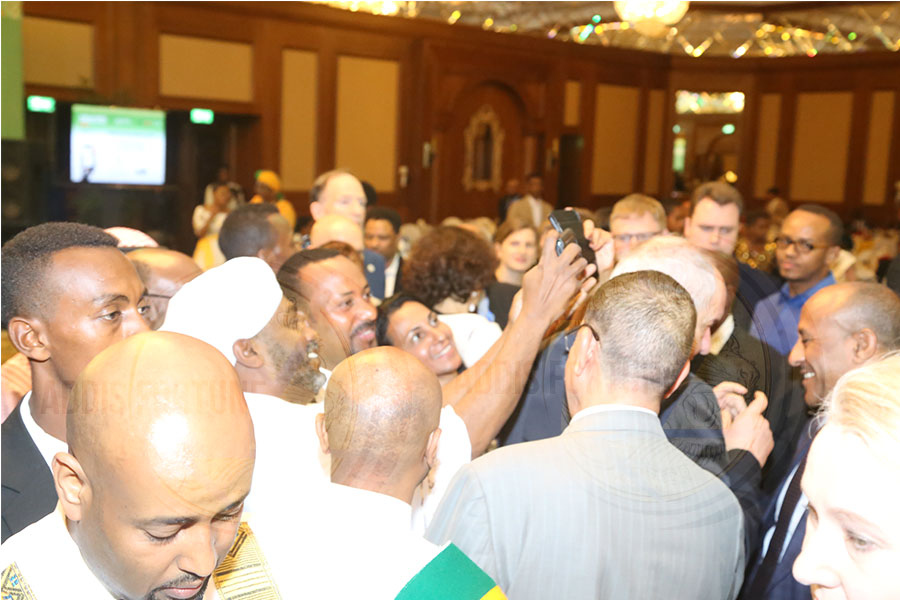
Photo Gallery | 180104 Views | May 06,2019
Dec 8 , 2024.
The Brewed Buck moved subtly but persistently against the Green Buck over the past week, uncovering deeper structural issues in the foreign exchange market. Between December 2 and December 7, 2024, rates among banks did more than adhere to standard pricing patterns. They unveiled intriguing outliers. Chief among them was Goh Betoch Bank, offering noticeably higher rates and raising questions about its executives' rationales in a market normally defined by uniform spreads and the state-owned Commercial Bank of Ethiopia’s (CBE) influence.
During the six days last week, the Birr’s buying rate averaged 123.9, while its average selling rate settled at 126.8. These represented a measured but steady depreciation, enough to show the Brewed Buck's ongoing weakness. Most banks maintained the mandated two percent spread between buying and selling, producing a near-constant margin that illustrated regulatory control. Yet Goh Betoch broke from this pack, posting figures above its peers and taking a position of unexpected lead.
On December 6 and 7, the Bank’s selling rate hit 127.368 Br, firmly at the top of the range. It also offered higher-than-average buying rates (124.87 Br), a strategy that might signal an aggressive attempt to pull in dollar inflows from a starved market. Whether this represents a competitive manoeuvre or a response to pressing liquidity needs. It distinguished Goh Betoch in an environment where outliers rarely appear without reason.
The state-owned CBE displayed its traditional conservatism, albeit with increasing rates. On December 7, it posted a buying rate of 122.59 Br, while its selling rate measured 125 Br. Among the lowest in the market, these rates may demonstrate CBE's capacity to resist pressures that push others toward more provocative strategies. As the largest and most influential financial institution, its executives' cautious approach could stabilise, curbing the market’s drift into more pronounced volatility.
Another outlier appeared to be Nib International Bank (NIB), which maintained the lowest buying rate at 121.6 Br for a dollar throughout the period.
Most private banks stayed firmly in the middle, with buying rates between 123.4 Br and 124.7 Br a dollar and selling rates from 125.5 Br to 127.2 Br. Their actions blended into a broad regulatory norm, leaving little room for strategic differentiation. Yet, there were moments that caught the eye.
The National Bank of Ethiopia (NBE) registered a strikingly low spread of 0.88pc on December 5, a sharp deviation from the industrial average. Awash International Bank (AIB) briefly pushed above the two percent boundary on December 2, reaching 2.02pc before quickly returning to compliance. These short-lived departures from the norm could be that some banks occasionally test the boundaries, only to return to safer ground.
Underlying these fluctuations is a consistent story of structural tension.
Ethiopia’s reliance on imports and modest dollar inflows through exports and remittances creates a forex market perennially short of hard currency. Demand outpaces supply, and banks find themselves in a perpetual scramble for the bucks. Goh Betoch Bank’s distinctive behaviour last week likely tells these pressures; perhaps it sought to fortify its reserves for near-term obligations, or perhaps its executives hoped that offering better rates would give them a competitive edge in securing scarce currency.
Last week revealed three distinct bank categories.
A group, including CBE and Nib, acts as stabilisers, favouring low rates and strict compliance that signal relative confidence. Another cluster, comprising first-generation private banks such as Dashen, Awash, and Wegagen, closely followed the regulatory framework, neither pushing nor lagging behind. The third category, with Goh Betoch at the forefront and occasionally joined by smaller players like NBE, teased with the edges of acceptable practice.
These developments point to a forex market under persistent stress. Outliers like Goh Betoch might draw short-term dollar inflows, but they also expose systemic fragility. Without the central bank demonstrating its firepower in forex and helping to boost export capacity, improve remittance flows, and rethink its overarching role, the Brewed Buck's incremental depreciation will likely continue. Banks will keep probing boundaries, regulators will enforce compliance, and the currency will edge downward as long-standing structural weaknesses remain unaddressed.
PUBLISHED ON
Dec 08,2024 [ VOL
25 , NO
1284]

Photo Gallery | 180104 Views | May 06,2019

Photo Gallery | 170302 Views | Apr 26,2019

Photo Gallery | 161318 Views | Oct 06,2021

My Opinion | 137244 Views | Aug 14,2021

Nov 1 , 2025
The National Bank of Ethiopia (NBE) issued a statement two weeks ago that appeared to...

Oct 25 , 2025
The regulatory machinery is on overdrive. In only two years, no fewer than 35 new pro...

Oct 18 , 2025
The political establishment, notably the ruling party and its top brass, has become p...

Oct 11 , 2025
Ladislas Farago, a roving Associated Press (AP) correspondent, arrived in Ethiopia in...